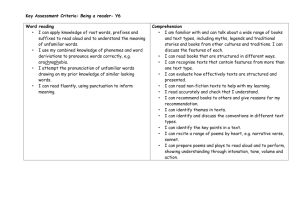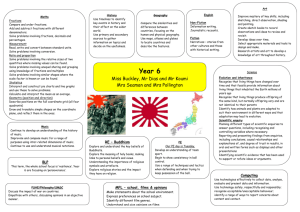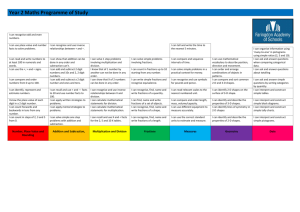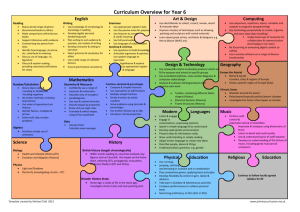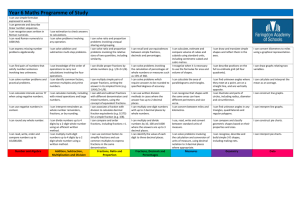Y6 Age-Related Expectations
advertisement
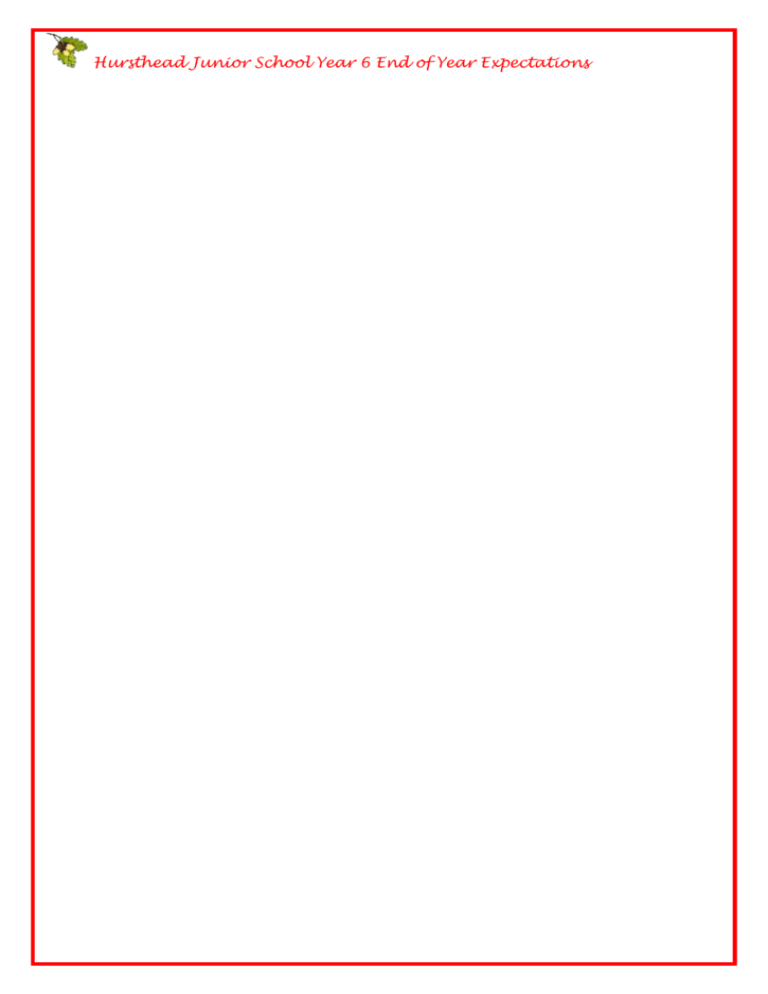
Hursthead Junior School Year 6 End of Year Expectations Hursthead Junior School Year 6 End of Year Expectations Hursthead Junior School Year 6 End of Year Expectations Hursthead Junior School Year 6 End of Year Expectations Mathematics Number, place value, approximation and estimation/rounding I can read, write, order and compare numbers up to 10,000,000. I can determine the value of each digit in numbers up to 10,000,000. I can round any whole number to a required degree of accuracy. I can use negative numbers in context, and calculate intervals across zero. I can solve number problems and practical problems with the above. Calculations I can use estimation to check answers to calculations and determine, in the context of a problem, an appropriate degree of accuracy. I can solve addition and subtraction multi-step problems in contexts, deciding which operations and methods to use and why. I can identify common factors, common multiples and prime numbers. I can perform mental calculations, including with mixed operations and large numbers. I can multiply multi-digit numbers up to 4 digits by a 2 digit whole number using the formal written method of long multiplication. I can divide numbers up to 4 digits by a 2 digit whole number using the formal written method of long division, and interpret remainders as whole number remainders, fractions, or by rounding, as appropriate for the context. I can divide numbers up to 4 digits by a 2 digit number using the formal written method of short division where appropriate. I can solve problems involving addition, subtraction, multiplication and division. I can use my knowledge of the order of operations to carry out calculations involving the four operations. Fractions, decimals and percentages I can use common factors to simplify fractions and use common multiples to express fractions in the same denomination. I can compare and order fractions, including fractions >1. I can add and subtract fractions with different denominators and mixed numbers, using the concept of equivalent fractions. I can multiply simple pairs of proper fractions, writing the answer in the simplest form. I can divide proper fractions by whole numbers. I can associate a fraction with division to calculate decimal fractions equivalents for a simple fraction. I can identify the value of each digit to 3 decimal places and multiply and divide numbers by 10, 100 and 1000 giving answers up to 3 decimal places. I can multiply 1-digit numbers with up to 2 decimal places by whole numbers. I can use written division methods in cases where the answer has up to 2 decimal places. I can solve problems which require answers to be rounded to specified degrees of accuracy. I can recall and use equivalences between simple fractions, decimals and percentages, including in different contexts. Ratio and proportion I can solve problems involving the relative sizes of two quantities, where missing values can be found using integer multiplication and division facts. I can solve problems involving the calculation of percentages and the use of percentage comparisons. I can solve problems involving similar shapes where the scale factor is known or can be found. I can solve problems involving unequal sharing and grouping using knowledge of fractions and multiples. Algebra I can express missing number problems algebraically. I can use a simple formulae. I can generate and describe linear number sequences. I can find pairs of numbers that satisfy an equation with two unknowns. I can enumerate possibilities of combinations of two variables. Measurement I can use, read, write and convert between standard units, converting measurements of length, mass, volume and time from a smaller unit of measure to a larger unit, and vice versa, using decimal notation of up to 3 decimal places. I can convert between miles and kilometres. I recognise that shapes with the same areas can have different perimeters and vice versa. I can calculate the area of parallelograms and triangles. I recognise when it is possible to use the formulae for the area of shapes. I can calculate, estimate and compare volume of cubes and cuboids, using standard units. I recognise when it is possible to use the formulae for the volume of shapes. I can solve problems involving the calculation and conversion of units of measure, using decimal notation up to 3 decimal places where appropriate. Geometry – properties of shapes I can compare and classify geometric shapes based on the properties and sizes. I can describe simple 3D shapes. I can draw 2D shapes given dimensions and angles. I recognise and build simple 3D shapes, including making nets. I can find unknown angles in any triangles, quadrilaterals and regular polygons. I recognise angles where they meet at a point, are on a straight line, or are vertically opposite, and find missing angles. I can illustrate and name parts of circles, including radius, diameter and circumference. I know the diameter is twice the radius. Geometry – position and direction I can draw and translate simple shapes on the co-ordinate plane, and reflect them in the axes. I can describe positions on the full co-ordinate grid (all four quadrants). Statistics I can interpret and construct pie charts and line graphs and use these to solve problems I can calculate and interpret the mean as an average. Hursthead Junior School Year 6 End of Year Expectations Physical Education Games • I can play to agreed rules. • I can explain rules. • I can umpire. • I can make a team and communicate plan. • I can lead others in a game situation. Athletics • I can demonstrate stamina. • I can make improvements to my skills technique in order to improve a PB. Outdoor and adventurous • I can plan a route and a series of clues for someone else. • I can plan with others taking account of safety and danger. Dance • I can develop sequences in a specific style. • I can choose my own music and style. Gymnastics • I can combine my own work with that of others. • I can link sequences to specific timings. Languages Spoken language • I can listen to others speaking a different language. • I can join in with songs and rhymes. • I can answer questions. • I can ask questions. • I can give an opinion. • I can speak in sentences. • I can link sentences together using simple conjunctions … y, pero, porque • I can speak with accurate pronunciation and intonation. • I can apply previously taught words and phrases in new contexts. • I can use accurate grammar when I am speaking … masculine/feminine; plural; 1st/2nd/3rd person; position of adjectives; use of negative. • I can hold a simple conversation with at least 4 exchanges. • I can begin to use ir followed by the infinitive to communicate about future events. Reading • I can understand a short story or factual text and note the main points. • I can use the context to work out unfamiliar words. Writing • I can write a paragraph of 4-5 sentences. • I can describe people, places and things in writing. • I can use a dictionary to advance my vocabulary. • I can use known phrases to create new sentences in writing. • I can explain what I like/dislike about a familiar topic. Hursthead Junior School Year 6 End of Year Expectations Science Working Scientifically (in Years 5 and 6) • I can plan different types of scientific enquiry. • I can control variables in an enquiry. • I can measure accurately and precisely using a range of equipment. • I can record data and results using scientific diagrams and labels, classification keys, tables, scatter graphs, bar and line graphs. • I can use the outcome of test results to make predictions and set up a further comparative fair test. • I can report findings from enquiries in a range of ways. • I can explain a conclusion from an enquiry. • I can explain causal relationships in an enquiry. • I can relate the outcome from an enquiry to scientific knowledge in order to state whether evidence supports or refutes an argument or theory. • Read, spell and pronounce scientific vocabulary accurately. Biology Living things and their habitats • I can classify living things into broad groups according to observable characteristics and based on similarities & differences. • I can describe how living things have been classified. • I can give reasons for classifying plants and animals in a specific way Evolution and inheritance • I can describe how the earth and living things have changed over time. • I can explain about reproduction and offspring (recognising that offspring normally vary and are not identical to their parents). • I can explain how animals and plants are adapted to suit their environment. • I can link adaptation over time to evolution. • I can explain evolution. Chemistry Properties and changes of materials • I can compare and group materials based on their solubility. • I can describe how a material dissolves to form a solution; explaining the process of dissolving. • I can describe and show how to recover a substance from a solution. • I can describe how some materials can be separated. • I can demonstrate how materials can be separated (e.g. through filtering, sieving and evaporating). • I know and can demonstrate that some changes are reversible and some are not. States of matter • I can describe how some materials can change state. • I can explore how materials change state. • I can describe the water cycle. • I can explain the part played by evaporation and condensation in the water cycle. Physics Electricity • • • Light • • • • I can explain how the number & voltage of cells in a circuit links to the brightness of a lamp or the volume of a buzzer. I can compare and give reasons for why components work and do not work in a circuit. I can draw circuit diagrams using correct symbols. I can explain how light travels. I can explain and demonstrate how we see objects. I can explain why shadows have the same shape as the object that casts them. I can explain how simple optical instruments work, e.g. periscope, telescope, binoculars, mirror, magnifying glass etc. Hursthead Junior School Year 6 End of Year Expectations Geography • • • • • • • I can answer questions by using a map. I can use Ordnance Survey symbols and 6 figure grid references. I can use maps, aerial photographs, plans and e-resources to describe what a locality might be like. I can describe how some places are similar and dissimilar in relation to their human and physical features. I can explain why many cities are situated on or close to rivers. I can explain why people are attracted to live by rivers. I can explain the course of a river. I can name and locate many of the world’s most famous rivers in an atlas.. History • I can place features of historical events and people from the past societies and periods in a chronological framework. • I can summarise the main events from a period of history, explaining the order of events and what happened. • I can summarise how Britain has had a major influence on the world. • I can summarise how Britain may have learnt from other countries and civilizations (historically and more recently). • I can identify and explain differences, similarities and changes between different periods of history. • I can identify and explain propaganda. • I can describe a key event from Britain’s past using a range of evidence from different sources. • I can describe the features of historical events and way of life from periods I have studied; presenting to an audience. Historical content • a local history study Design and Technology • • • • • • • • I can use market research to inform my plans and ideas. I can follow and refine my plans. I can justify my plans in a convincing way. I can show that I consider culture and society in my plans and designs. I show that I can test and evaluate my products. I can explain how products should be stored and give reasons. I can work within a budget. I can evaluate my product against clear criteria. Food Technology Skills • • • • • • • • • • • • • • • • • • • Measure foods using common terms, e.g. knob of butter Judge when food is clean and ready to use core an apple or pear using an apple corer Juice an orange or lime by squeezing it around a fork Use a vegetable or serrated knife to remove skin, e.g. mango Separate the yolk from the white by juggling the yolk between the 2 halves of shell Slice and dice foods safely, e.g. strips of pepper, cubes of cheese Chop herbs finely Push soft fruit through a sieve into a bowl, removing the pips Know when a mixture is creamed by its pale colour, creamy texture and aeration Gently fold sugar into whisked egg white Know that rapid boiling is only suitable for some foods, such as rice and pasta, and simmering is better for vegetables, as it is less damaging Drain hot liquid safely away from foods using a colander, e.g. pasta Judge how long to ‘blend’ for a desired consistency, e.g. some chunks, coarse, smooth Know exactly when to stop rubbing-in, checking that there are no large lumps (by shaking the bowl), and using fingertips Use a balloon whisk, e.g. to thicken cream Cut out shapes with attention to making maximum use of dough without waste Check that food being baked is cooked - usually golden brown on the surface, or for bread it sounds hollow when you tap the base Thoroughly wash and scrub cooking equipment, e.g. saucepans, casserole dishes and baking trays Hursthead Junior School Year 6 End of Year Expectations Computing Algorithms and programming • I can design a solution by breaking a problem up. • I recognise that different solutions can exist for the same problem. • I can use logical reasoning to detect errors in algorithms. • I can use selection in programs. • I can work with variables. • I can explain how an algorithm works. • I can explore ‘what if’ questions by planning different scenarios for controlled devices. Information technology • I can select, use and combine software on a range of digital devices. • I can use a range of technology for a specific project. Digital literacy • I can discuss the risks of online use of technology. • I can identify how to minimise risks. Art • • • • • • I can explain why I have used different tools to create art. I can explain why I have chosen specific techniques to create my art. I can explain the style of my work and how it has been influenced by a famous artist - Henry Moore. I can over print to create different patterns. I can use feedback to make amendments and improvement to my art. I can use a range of e-resources to create art. Music • • • • • • • I can sing in harmony confidently and accurately. I can perform parts from memory. I can take the lead in a performance. I can use a variety of different musical devices in my composition (including melody, rhythms and chords). I can evaluate how the venue, occasion and purpose affects the way a piece of music is created. I can analyse features within different pieces of music. I can compare and contrast the impact that different composers from different times have had on people of that time. Religious Education (non-statutory) I can use an increasingly wide religious vocabulary to explain the impact of beliefs on individuals and communities. I can ask, and suggest answers to, questions of identity, belonging, meaning, purpose and truth, values and commitments, relating them to my own and others' lives. Hursthead Junior School Year 6 End of Year Expectations English Reading I can apply knowledge of root words, prefixes and suffixes to read aloud and to understand the meaning of unfamiliar words. I use my combined knowledge of phonemes and word deriviations to pronounce words correctly, e.g. arachnophobia. I attempt the pronunciation of unfamiliar words drawing on my prior knowledge of similar looking words. I can read fluently, using punctuation to inform meaning. I am familiar with and can talk about a wide range of books and text types, including myths, legends and traditional stories and books from other cultures and traditions. I can discuss the features of each. I can read books that are structured in different ways. I can recognise texts that contain features from more than one text type. I can evaluate how effectively texts are structured and presented. I can read non-fiction texts to help with my learning. I read accurately and check that I understand. I can recommend books to others and give reasons for my recommendation. I can identify themes in texts. I can identify and discuss the conventions in different text types. I can identify the key points in a text. I can recite a range of poems by heart, e.g. narrative verse, sonnet. I can prepare poems and plays to read aloud and to perform, showing understanding through intonation, tone, volume and action. Writing Vocabulary, grammar and punctuation Manipulate sentences to create particular effects Use devices to build cohesion between paragraphs in persuasive, discursive and explanatory texts e.g. on the other hand, the opposing view, similarly, in contrast, although, additionally, another possibility, alternatively, as a consequence Use devices to build cohesion between paragraphs in narrative e.g. in the meantime, meanwhile, in due course, until then Use ellipsis to link ideas between paragraphs Identify and use colons to introduce a list Identify and use semi-colons to mark the boundary between independent clauses e.g. It is raining; I am fed up. Investigate and collect a range of synonyms and antonyms e.g. mischievous, wicked, evil, impish, spiteful, well-behaved Explore how hyphens can be used to avoid ambiguity e.g. man eating shark versus man-eating shark Punctuate bullet points consistently Explore and collect vocabulary typical of formal and informal speech and writing e.g. find out –discover, ask for - request, go in – request Identify the subject and object of a sentence Explore and investigate active and passive e.g. I broke the window in the greenhouse versus the window in the greenhouse was broken Composition I can plan my writing by: • Identifying audience and purpose • Choose appropriate text-form and type for all writing • Selecting the appropriate language and structures • Drawing on similar writing models, reading and research • Using a range of planning approaches e.g. storyboard, story mountain, discussion group, post-it notes, ICT story planning I can draft and write by: • Selecting appropriate vocabulary and language effects, appropriate to task, audience and purpose, for precision and impact • Introducing and developing characters through blending action, dialogue and description within sentences and paragraphse.g. Tom stomped into the room, flung down his grubby, school bag and announced, through gritted teeth, “It’s not fair!” • Using devices to build cohesion • Deviating narrative from linear or chronological sequence e.g. flashbacks, simultaneous actions, time shifts • Combining text-types to create hybrid texts e.g. persuasive speech • Evaluating, selecting and using a range of organisation and presentational devices for different purposes and audiences • Finding examples of where authors have broken conventions to achieve specific effects and using similar techniques in own writing – e.g. repeated use of ‘and’ to convey tedium, one word sentence. • Make conscious choices about techniques to engage the reader including appropriate tone and style e.g. rhetorical questions, direct address to the reader • Use active and passive voice to achieve intended effects e.g. in formal reports, explanations and mystery narrative I can evaluate and edit by: • Reflecting upon the effectiveness of writing in relation to audience and purpose, suggesting and making changes to enhance effects and clarify meaning • Proofreading for grammatical, spelling and punctuation errors I can evaluate and improve the performances of my compositions focusing on: • Intonation and volume • Gesture and movement • Audience engagement Spelling Be secure with all spelling rules previously taught Write increasingly confidently, accurately and fluently, spelling with automaticity Use a number of different strategies interactively in order to spell correctly Develop self-checking and proofchecking strategies Use independent spelling strategies for spelling unfamiliar wordsHandwriting Write with increasing speed Choosing the writing implement that is best suited for a task (e.g. quick notes, letters) Speaking and Listening • I talk confidently and fluently in a range of situations, using formal and Standard English, if necessary. • I ask questions to develop ideas and take account of others’ views. • I explain ideas and opinions giving reasons and evidence. • I take an active part in discussions and can take on different roles. • I listen to, and consider the opinions of, others in discussions. • I make contributions to discussions, evaluating others’ ideas and respond to them. • I can sustain and argue a point of view in a debate, using the formal language of persuasion. • I can express possibilities using hypothetical and speculative language. • I engage listeners through choosing appropriate vocabulary and register that is matched to the context. • I can perform my own compositions, using appropriate intonation, volume and expression so that literal and implied meaning is clear. • I can perform poems and plays from memory, making deliberate choices about how to convey ideas about characters, contexts and atmosphere.

